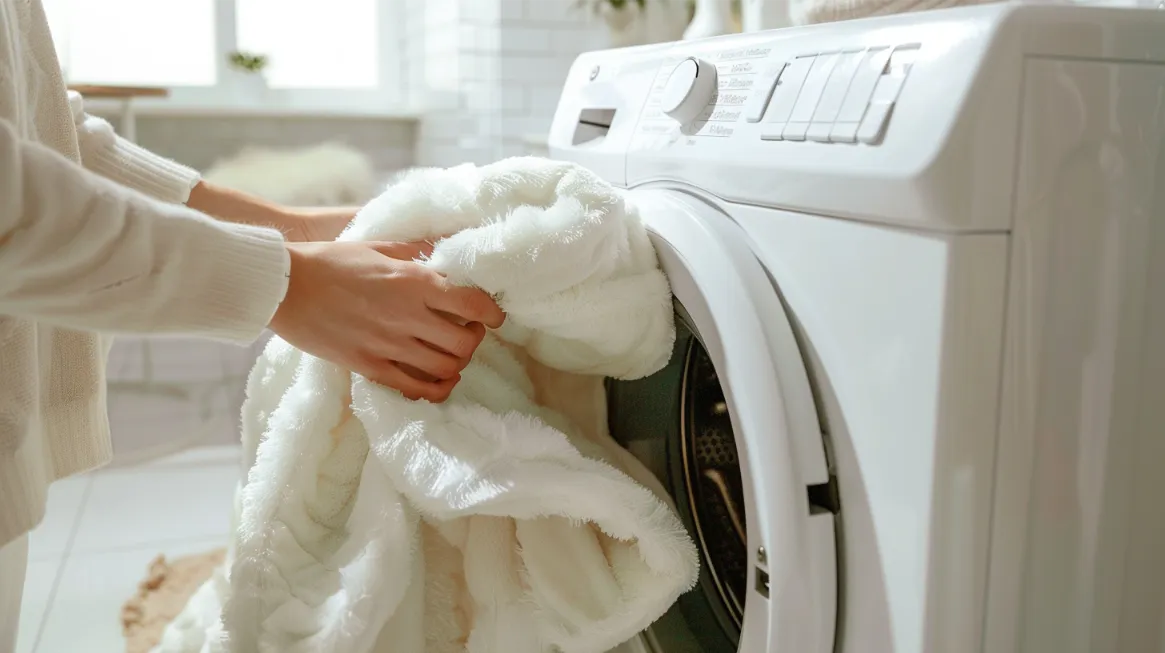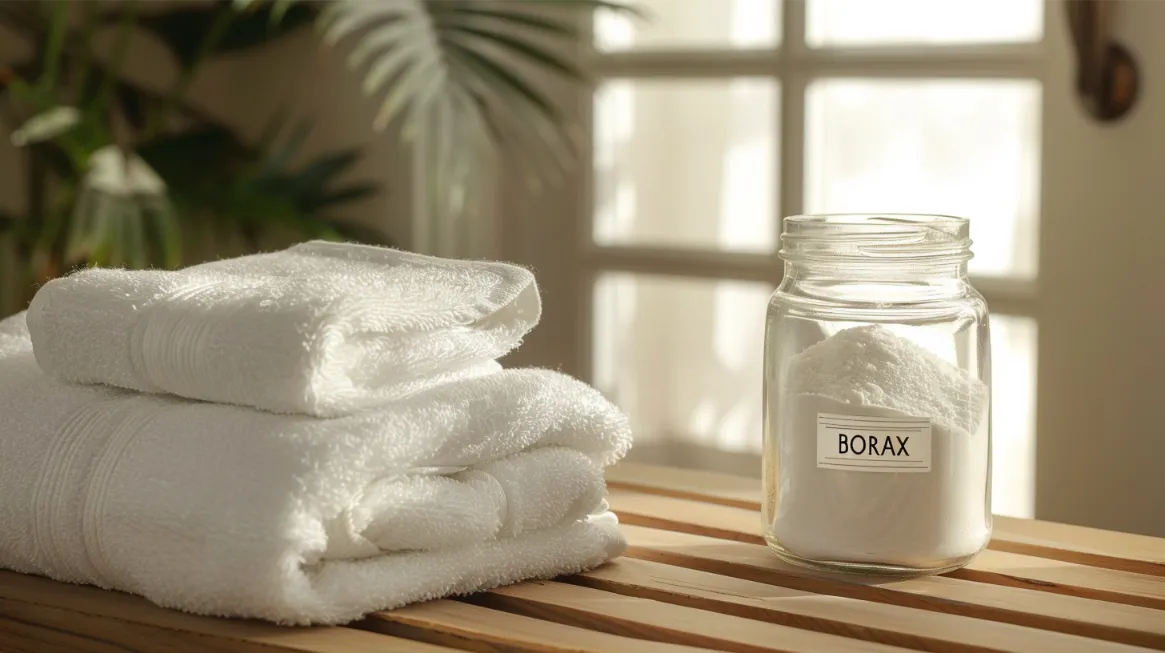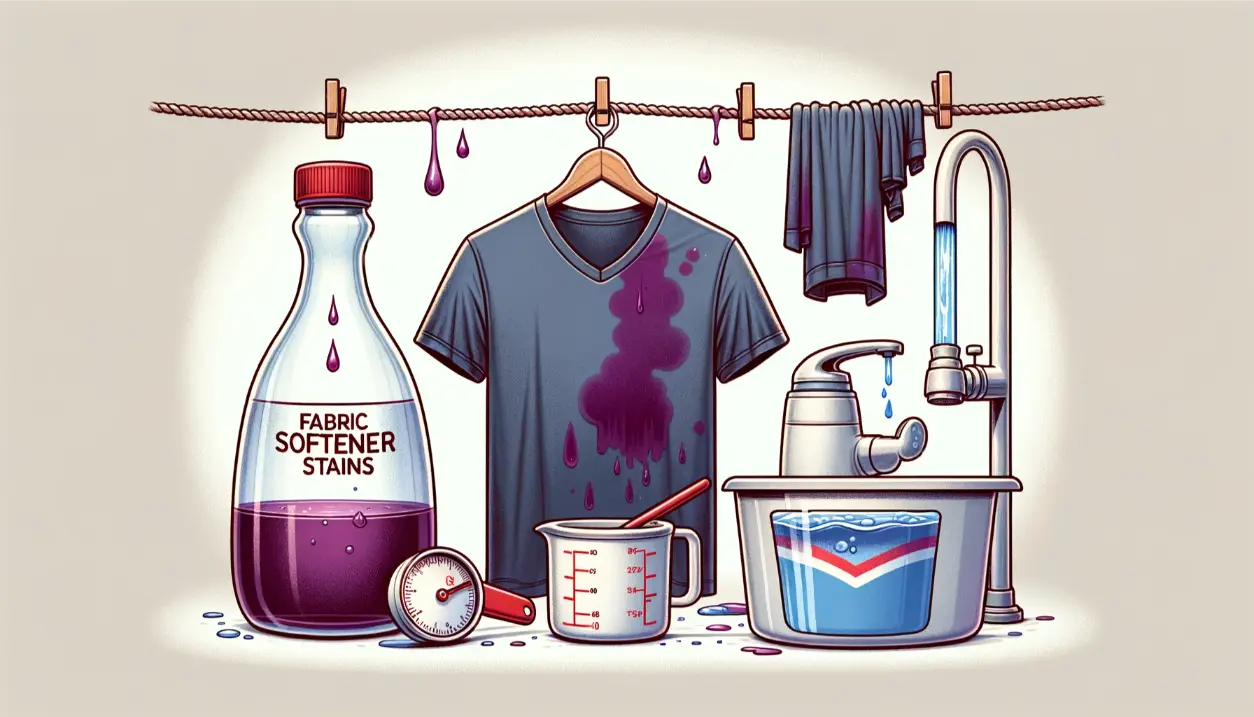The mildew smell of washing machines is a common and frustrating problem many households face. This unpleasant odor, often musty, damp, or reminiscent of rotten eggs, can permeate your laundry room and linger on your supposedly clean clothes. Understanding the causes behind this issue and learning effective solutions are crucial for maintaining a fresh-smelling laundry space and ensuring your garments are spotless.
Recent studies have shed light on the prevalence of mold and mildew in household washing machines. A study by the University of Arizona found that 79% of the 70 washing machines sampled contained fungi. Furthermore, research suggests that many laundry machines harbor mold, mildew, viruses, and bacteria that can survive standard wash cycles. These microorganisms thrive in the damp, dark environment of the washer, particularly in crevices like the rubber door gasket.
The primary culprits behind washing machine odors are mold, mildew, and bacteria that feed on soap scum, dirt, hair, and fabric softener residue. Front-loading machines are especially prone to developing mildew smells due to their design, which allows water to pool in the gasket and other hard-to-reach areas. However, top-loading washers are not immune to this issue, as they can also accumulate residue and moisture that lead to unpleasant odors.
In the following sections, we will delve into the signs of mildew growth in your washing machine, explore effective prevention strategies, and provide step-by-step cleaning methods to eliminate odors. By implementing regular maintenance and addressing any persistent issues promptly, you can ensure your laundry emerges clean, fresh-smelling, and free from harmful microorganisms.
Signs of Mildew in Your Washing Machine
A moldy washing machine is unpleasant and potentially hazardous to your health. Knowing how to identify the signs of mildew growth is crucial for maintaining a clean and safe laundry environment. While a visual inspection can often reveal obvious mold colonies, other telltale indicators indicate that your washer may harbor unwanted fungal growth.
A musty or earthy odor emanating from the empty drum is a common sign of mildew in a washing machine. This distinctive smell is caused by microbial volatile organic compounds (MVOCs) released by the actively growing mold. If your freshly laundered clothes come out smelling worse than when they went in, it strongly indicates mold has taken hold somewhere in your machine.
Visible mold growth is another clear sign of a mildew problem. Mold can appear in various colors, including black, green, brown, or gray, and may have a powdery or slimy texture. Common areas where mold accumulates include the rubber door gasket (especially in front-loading machines), the detergent dispenser, and the drum itself. A flashlight to inspect these crevices thoroughly can help you spot any suspicious growth.
Even if you don’t see visible mold, your laundry may exhibit other signs of contamination. Clothes from the wash with musty odors or even visible mold spots indicate that fungal spores have infiltrated the fibers. Damp clothes left in the washer for too long can quickly become a breeding ground for mildew, leading to persistent odors and stains.
Health symptoms can also point to a mold problem in your washing machine. Exposure to mold spores can trigger allergic reactions, respiratory issues, and other health concerns. It may be due to mold exposure if you experience symptoms like sneezing, coughing, itchy eyes, or skin irritation when handling laundry or spending time in the laundry room.
Regular inspection and maintenance are key to identifying mold early and preventing it from spreading. If you notice any mildew in your washing machine, swift action is necessary to eliminate the growth and restore a fresh, healthy laundry environment. The following sections explore effective prevention strategies and cleaning methods to keep your washer mold-free.
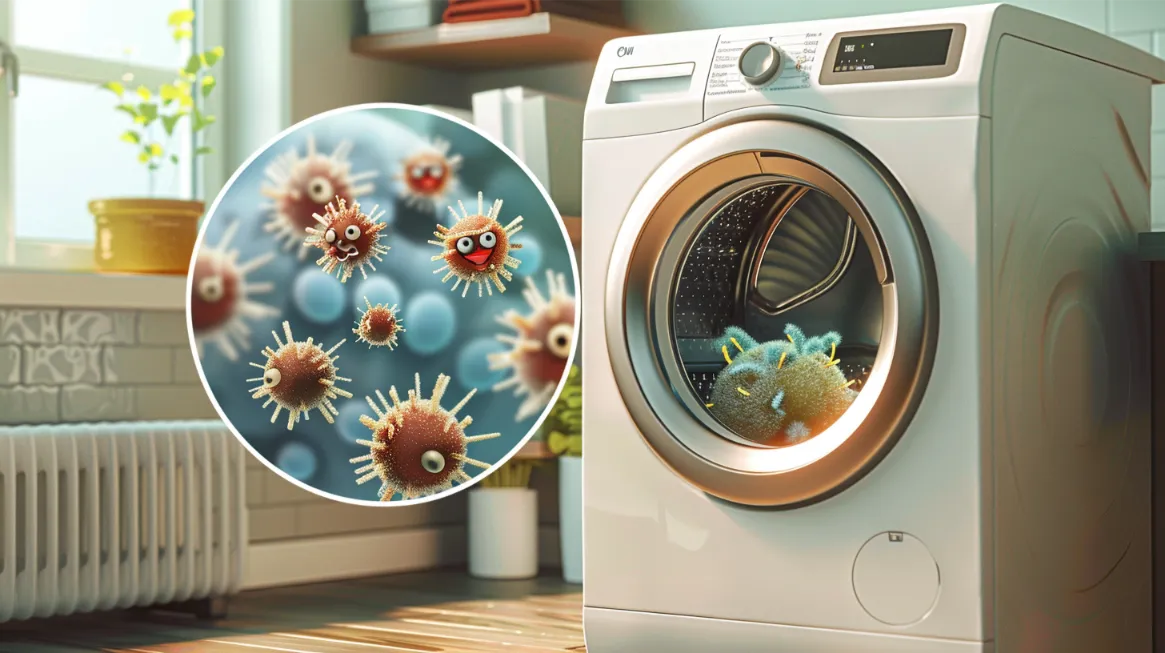
Causes of Mildew Growth in Washing Machines
Several factors contribute to the growth of mold and mildew in washing machines, creating an ideal environment for these fungi to thrive. Understanding these causes is crucial for effectively preventing and eliminating mildew odors in your laundry room.
One of the primary culprits behind mildew growth is moisture retention, particularly in front-loading washing machines. The design of front-loaders, with their airtight door seals, can trap moisture inside the drum and gaskets, providing the damp conditions that mold and mildew need to flourish. This issue is compounded when the washer is used infrequently or if the door remains closed between cycles, allowing humidity to build up.
Detergent and fabric softener residue can also play a significant role in mildew growth. When too much detergent or non-HE (high-efficiency) products are used in HE machines, the excess suds and residue can accumulate in the washer’s crevices. This buildup provides a food source for mold and mildew, enabling them to multiply rapidly.
Leaving wet clothes in the washing machine for extended periods is another common cause of mildew growth. A closed washer’s damp, dark environment with wet laundry inside is the perfect breeding ground for mold spores. As the spores multiply, they can spread to the machine’s interior and even transfer onto your clothing, leading to musty odors.
Poor ventilation in the laundry room can exacerbate mildew issues by maintaining high humidity levels. The damp conditions persist without adequate airflow to help moisture evaporate, encouraging mold growth in the washer and nearby surfaces.
You can effectively combat this common laundry room issue by understanding the underlying causes of mildew growth and implementing targeted prevention strategies. In the following sections, we’ll delve into specific steps you can take to keep your washing machine and laundry smelling clean and fresh.
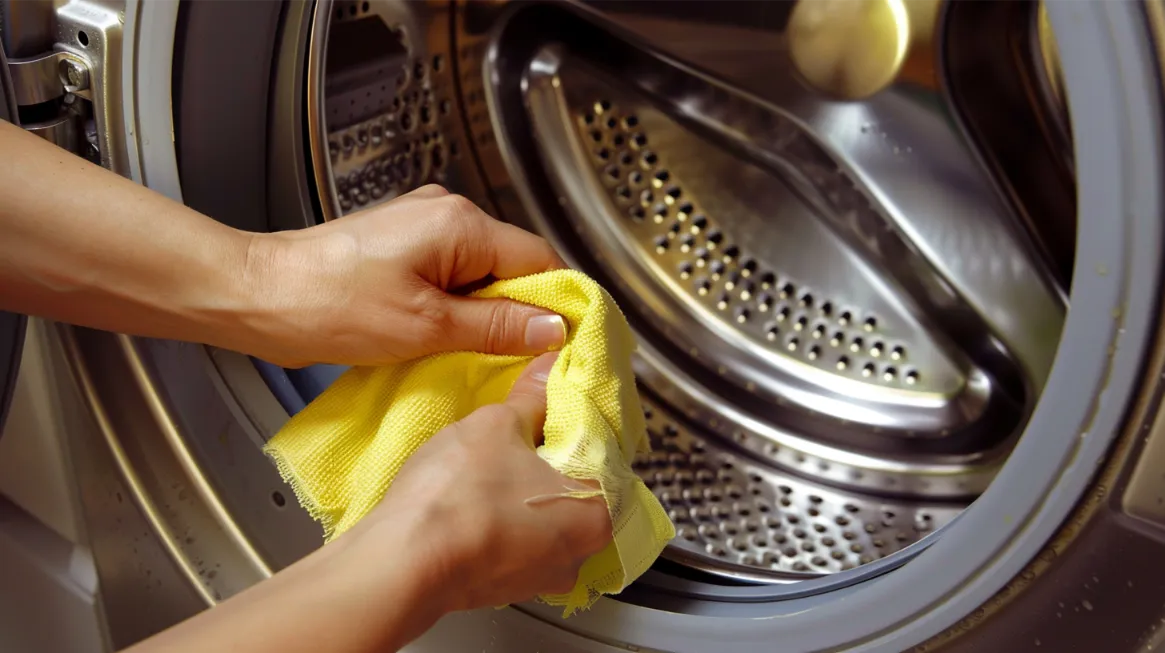
Cleaning Methods for Removing Mildew Smell
When your washing machine or clothes develop that dreaded musty, mildew smell, it’s crucial to take action to eliminate the odor and prevent it from returning. Fortunately, several effective cleaning methods can banish mildew smells using common household ingredients.
One of the simplest solutions is to run an empty hot wash cycle with white vinegar. Add 2 cups of distilled white vinegar directly into the drum, and run the washer on the hottest setting. Vinegar is a natural disinfectant that kills odor-causing bacteria and dissolves mineral buildup. Add 1/2 cup of baking soda to the cycle for extra deodorizing power for stubborn smells.
If the mildew smell persists, it’s time to clean the washer’s components deep. Start by wiping down the rubber gasket around the door with a 50/50 mixture of water and bleach, making sure to get into all the crevices where mold can hide. For front-loaders, cleaning the gasket regularly is essential to prevent moisture and debris from accumulating.
Next, remove and soak the detergent dispenser in warm, soapy water, scrubbing away any built-up residue with an old toothbrush. Don’t forget to clean the slot where the dispenser fits, as mildew can also grow there.
For a more heavy-duty approach, use a commercial washing machine cleaner or a homemade solution of 1/4 cup baking soda mixed with 1/4 cup water. Apply this paste to the drum and scrub thoroughly, then run an empty hot cycle to rinse it away. Add 1 cup of oxygen bleach or borax to a cycle for extra cleaning power.
In addition to cleaning the machine, it’s important to address musty-smelling clothes—Pre-soak heavily soiled or mildewy items in 1 cup of vinegar per gallon of warm water before laundering. Add 1 cup of baking soda to the wash cycle and your regular detergent to help neutralize odors. Try using an enzymatic cleaner to remove mildew odors from fabrics for persistent smells.
To keep your washer fresh between deep cleanings, avoid leaving the door ajar after each use to allow air circulation and prevent moisture buildup. Wipe the gasket and drum with a dry cloth to remove excess water after each wash. Always promptly transfer wet laundry to the dryer to avoid letting damp clothes sit in the washer.
By employing these cleaning methods regularly and following good laundry habits, you can effectively eliminate mildew smells from your washing machine and enjoy fresh, clean-smelling clothes every time. Don’t let musty odors take over your laundry room – fight back with these proven techniques and breathe easy, knowing your washer is hygienically clean.
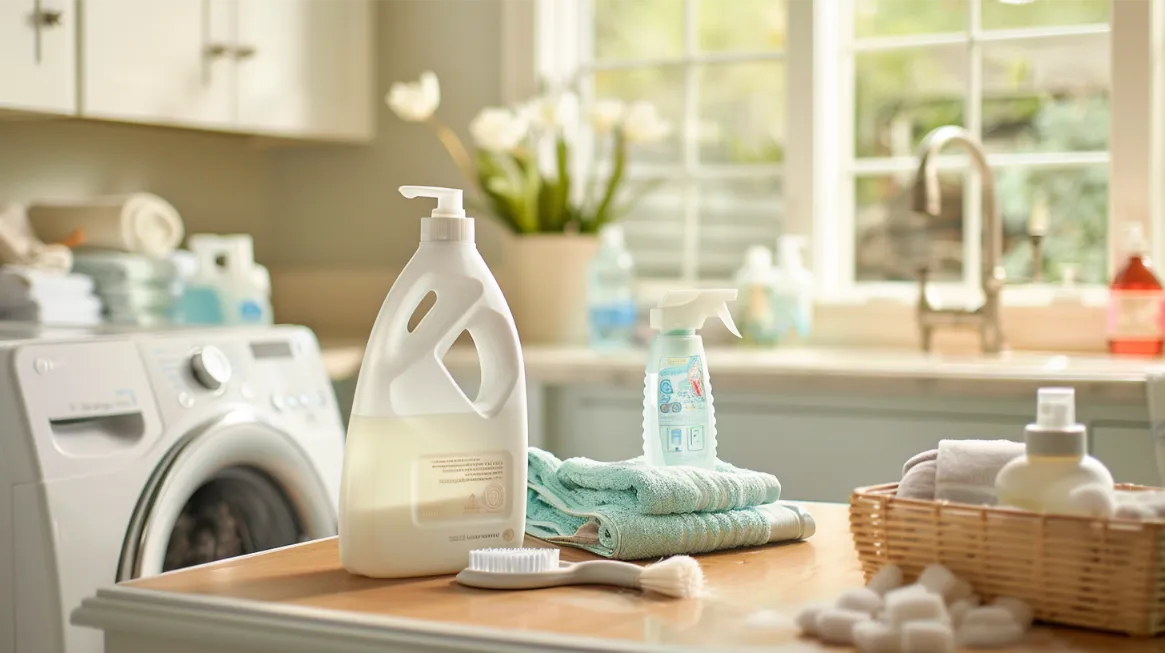
Maintaining a Fresh-Smelling Washing Machine
Keeping your washing machine smelling fresh and clean is an ongoing process that requires regular attention and maintenance. By incorporating a few simple habits into your laundry routine, you can prevent the buildup of odor-causing residue and ensure your washer remains a hygienic environment for cleaning your clothes.
One of the most effective ways to maintain a fresh-smelling washing machine is to conduct regular service washes. These cycles, typically run monthly, involve running an empty hot wash with a specialized washing machine cleaner or a mixture of white vinegar and baking soda. Service washes help to eliminate detergent buildup, soap scum, and any nascent mold or mildew growth, leaving your machine sparkling clean and odor-free.
In addition to monthly deep cleans, it’s crucial to practice good habits after each laundry load. Wiping down the washer’s gasket, or rubber seal, after every use can go a long way in preventing the accumulation of moisture and debris that can lead to mildew growth. Use a clean, dry cloth or paper towel to remove any visible water droplets or lint, paying special attention to the folds and crevices where grime tends to collect.
Proper ventilation is another key factor in maintaining a fresh-smelling washing machine. Leaving the washer door or lid slightly ajar between cycles allows air to circulate inside the drum, helping to dry out any remaining moisture and discouraging mold and mildew growth. If you have young children or curious pets, ensure the door is safely propped open without posing a risk of accidental closure or entrapment.
Using a dehumidifier in the laundry room can be a game-changer for those living in particularly humid environments or struggling with persistent musty odors. By reducing the overall moisture levels in the air, a dehumidifier creates a less hospitable environment for mold and mildew to thrive, thus minimizing the risk of odors developing in your washing machine.
In addition to these maintenance practices, using the correct type and amount of detergent for your machine is essential. High-efficiency (HE) washers require specially formulated low-sudsing detergents to prevent excess soap residue from accumulating in the machine’s components. Always measure your detergent according to the manufacturer’s guidelines, as too much can lead to a buildup and contribute to unpleasant odors.
These simple yet effective maintenance habits can keep your washing machine smelling fresh and ensure a hygienic laundry experience. Regular cleaning, proper ventilation, and appropriate detergents will go a long way in preventing the development of musty odors and extending the life of your appliance. Remember, a little proactive care can save you from the headache of dealing with a smelly washer down the line.
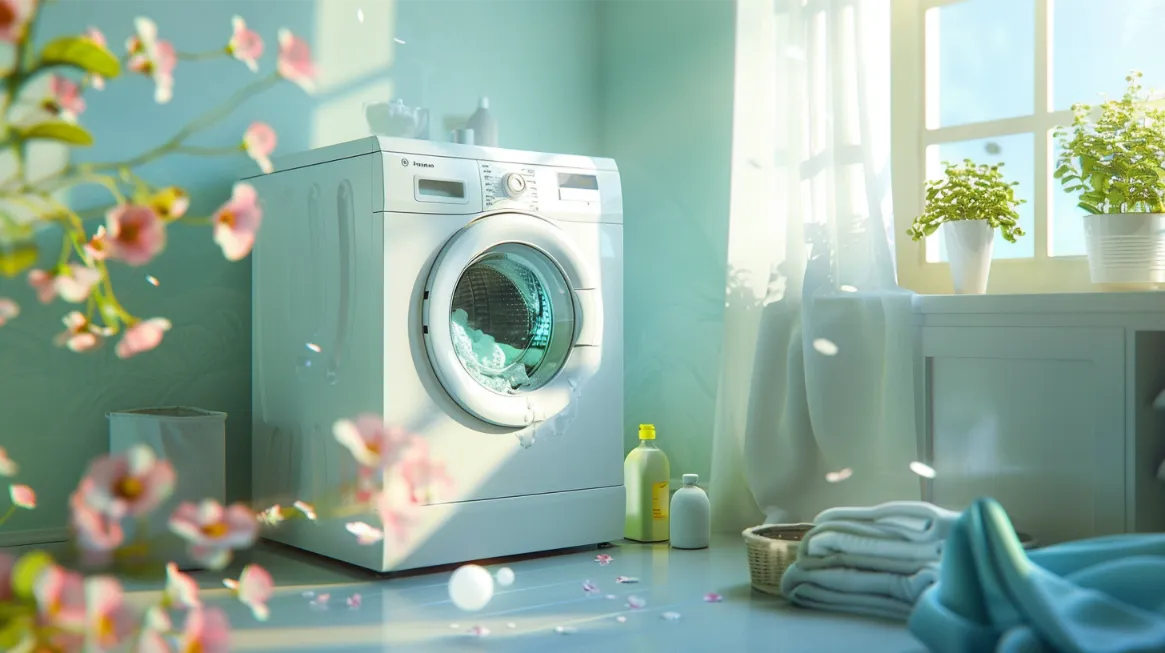
Addressing Persistent Mildew Issues
Despite your efforts to clean and maintain your washing machine, stubborn mildew odors may linger. If you’ve tried the cleaning methods outlined in the previous sections but still notice a musty smell, it’s time to take a more targeted approach to address these persistent issues.
One of the first steps is to check for clogs or standing water in your washing machine. Mildew thrives in damp, stagnant environments, so proper drainage is crucial. Inspect the drain hose and filter for any blockages, and clean them out if necessary. If you notice water pooling in the drum or detergent dispenser, it’s a sign that your machine isn’t draining correctly, which can contribute to mildew growth.
A professional cleaning service is worth considering if drainage issues aren’t the culprit. While DIY methods can be effective for routine maintenance, a professional deep clean can help eliminate mildew that’s taken hold in hard-to-reach areas. Look for a reputable company specializing in appliance cleaning and has experience dealing with mold and mildew in washing machines.
Sometimes, persistent mildew problems may indicate that investing in a new washing machine is time. If your current model is old or has a history of mildew issues, upgrading to a newer, more efficient machine with built-in mildew-resistant features can be a worthwhile investment. Look for models with advanced ventilation systems, antimicrobial components, and self-cleaning cycles designed to combat mold and mildew growth.
When shopping for a new washer, consider front-loading models with a tight door seal and minimal crevices where water can collect. Some newer machines also feature special antimicrobial finishes on the drum and gaskets, which can help prevent mildew from taking hold. While these features may come at a higher upfront cost, they can save you time and frustration in the long run by keeping your laundry fresh and mildew-free.
If you cannot replace your washing machine, there are still steps you can take to manage persistent mildew issues. A dehumidifier in your laundry room can help control moisture levels and prevent mildew growth. Add a cup of white vinegar or baking soda to each wash cycle to help neutralize odors and break down mildew-causing residue.
Addressing stubborn mildew problems in your washing machine requires targeted cleaning, proactive maintenance, and, sometimes, professional intervention or appliance upgrades. By staying vigilant and taking action at the first sign of mildew, you can keep your laundry smelling fresh and extend the life of your machine.
Conclusion
In conclusion, washing machine mildew smells are a common but solvable problem that many households face. By understanding the causes of mildew growth, recognizing the signs, and implementing effective prevention and cleaning strategies, you can keep your laundry smelling fresh and your washing machine in top condition.
Regular maintenance is key to preventing the buildup of odor-causing residue and mold spores. Adopting simple habits like leaving the washer door open after each use, wiping down the gasket, and using the correct type and amount of detergent can go a long way in maintaining a mildew-free machine. Conducting monthly service washes with vinegar, baking soda, or a specialized cleaner will also help eliminate any nascent mildew growth and keep your washer smelling clean.
Prompt action is crucial if you notice signs of mildew, such as musty odors or visible growth. Cleaning the gasket, drum, and dispensers with a mixture of water and bleach or vinegar can help remove mildew and restore freshness. A professional deep clean or upgrading to a mildew-resistant washing machine may be necessary for stubborn issues.
The benefits of a fresh-smelling washing machine extend beyond just pleasant-scented laundry. A mildew-free washer promotes a healthier home environment by reducing the risk of mold exposure, which can trigger allergies and respiratory issues. It also helps extend the life of your machine and your clothes, as mildew can cause damage to both over time.
Following the tips and techniques outlined in this article, you can effectively combat mildew smells on the washing machine and enjoy peace of mind with fresh, clean laundry. Remember, proactive maintenance and prompt attention to any issues can save you time, money, and frustration in the long run.
If you struggle with persistent mildew problems despite your best efforts, don’t hesitate to seek professional help or consider upgrading your machine. With the right tools, knowledge, and habits, you can keep your washing machine and laundry smelling fresh and mildew-free for years.





